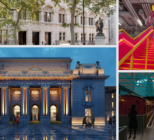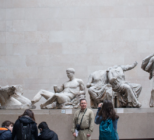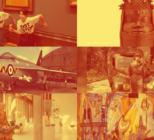To allow you to cast your mind back to the beginning of the year – one which seems at once far less and far more than twelve months ago – 2021 began with news coverage of an attempted coup in America, and English schools began closing as a new nationwide lockdown was introduced.
In the museums and heritage sector, the year began with a hurried response to lockdown, and for another year – one which was hoped to center around recovery – the pandemic coloured almost every event and announcement. Emergency funding was warmly welcomed. Attractions scrambled to creatively reimagine their offering. Multi-year plans were redrawn. Museums and heritage sites leapt into the digital world.
January
Among them was the Museum of London, which moved to acquire 13 viral tweets by Londoners on the subject of lockdown, part of Going Viral, a strand of its Collecting Covid project.
And among museums pivoting to virtual alternatives was London Transport Museum, which found a way to carry on its Hidden London tours despite the lockdown, with a virtual walk-through gallery of photos, videos and never-before-seen footage of the underground by an expert guide.
Hidden London virtual tours from London Transport Museum ‘close as possible to the real thing’
Also turning to digital was the Natural History Museum, which announced a partnership with Alibaba-owned online travel platform Fliggy to stream a two-hour tour to a 100,000 strong Chinese audience.
Natural History Museum livestream partnership with Alibaba platform reaches new Chinese audiences
Meanwhile, January’s Museum Selfie Day changed its brief to accommodate the changes. In its eighth year, users dug out their favourite selfies from years gone by.
February
Digital ‘pivots’ continued into February, despite much uproar from the sector over the decision to prevent museums and heritage attractions opening until at least five weeks later than business such as shops and gyms.
Those moving with the tide included Birmingham Museums, which unveiled a new subscription service which offered its users – anywhere in the world – access to exclusive digital content for a monthly fee. Birmingham Museums On Demand was developed to protect the future of Birmingham Museums Trust, with all profits being ploughed directly into the museum group’s operations.
Birmingham Museums On Demand to offer monthly worldwide subscription service
The National Gallery celebrated its own online success, revealing the top 20 paintings viewed on its website during lockdown. The announcement was complete with the suggestion that the subjects of many of the paintings were ‘all dressed up with nowhere to go’.
March
In the Spring Budget, Chancellor Rishi Sunak revealed an extra £300 million would be made available via the Culture Recovery Fund, with England’s museums and cultural organisations additionally eligible for around £90 million in support, ring fenced for the challenges posed before reopenings in May.
While digital pivots continued, Advisor covered some of the positive opportunities for closed attractions. Firstly in piquing public interest by appearing on the nation’s TV screens, and secondly as an opportunity to better understand accessibility.
The pandemic as an opportunity to reimagine accessibility in museums and heritage
April
Hot off the heels of its online success earlier in the year, The National Gallery launched a mobile edition of an exhibition which had initially been designed for delivery in socially distanced pods, instead enabling users to zoom into visual details and even share minute aspects of paintings via Instagram.
National Gallery reimagines immersive, socially distanced show as smartphone exhibition
Also in April, visitor experience specialist Colin Mulberg told Advisor about the opportunities and challenges of connecting with returning audiences, warning that museums waiting for a return to ‘normal’ after Covid-19 are “taking a huge risk”.
Advisor also considered the idea – and representation – of the home, profiling the likes of the the Museum of the Home’s collecting project Stay Home, which presented photos of self-isolation in its many forms from submissions by key workers, flat-sharers, parents and people from all other walks of life.
May
A day of celebration for the sector, but the start of new challenges, as museums, galleries and indoor heritage attractions reopen across England and Wales in an ‘emotionally significant moment for the nation’ on May 17th.
Attractions were tasked not only with a warm welcome for their first visitors, but the reintroduction of mask wearing, one-way systems, hand sanitising stations, and reduced capacities.
Also in May, the Museums + Heritage Awards announced its 2021 shortlist (entries are now open for 2022!)
June
In June, headlines focussed on the appointment of former chancellor of the exchequer George Osborne, who received unanimous approval from the British Museum’s Board of Trustees to take on the role of chair.
British Museum confirms appointment of former chancellor George Osborne as chair
Also in June came more welcome funding news, as Art Fund opened applications for its £2 million Reimagine grants scheme, (later, in October announcing the first 22 recipients)
Art Fund unveils summer funding plans worth over £2m to the sector
Advisor also asked if the arts could help foster a nationwide love affair with nature, as it profiled the Oak Project and its remit to boost public engagement with the natural world.
Can the arts help foster a nationwide love affair with nature?
July
By July the sector had begun to focus on recovery, as legal restrictions were lifted in England.
The Science Museum Group’s ambitious new storage facility took another step towards its 2024 public opening, as the first of over 300,000 objects were placed at the National Collections Centre.
Among the museums opening its doors was Manchester Jewish Museum. After more than two years closed, it revealed the result of a £6m redevelopment. Max Dunbar, Manchester Jewish Museum CEO (who would later in the year announce his departure) described the refreshed museum a “contemporary, thoughtful, welcoming new building which fuses the old with the new and which complements and integrates so well into our local area”.
Open doors: Manchester Jewish Museum seeks to bring diverse audiences together after £6m overhaul
August
In August, to allow the public to find nearby museums and galleries as they once again head out, Art Pass launched its online platform Unbooked, after research found that 65% of those planning a visit would be headed to one of the nation’s ten biggest institutions.
The location-based platform was designed to guide visitors to one of more than 2,000 smaller sites throughout the British Isles which were struggling with recovery.
New Art Fund platform aims to connect tourists with nearby museums and galleries
Also in August, the University of Oxford’s Bodleian Libraries announced a milestone in its digitisation project, having added its millionth item to its publicly accessible website.
Advisor covered valuable new research from AIM on the effect of admission fees. Among its findings, it was suggested there is little difference between the quality of visit at paid admission sites and free entry sites, but that there is evidence that charging entry improves the quality of the visitor welcome.
Should museums charge admission fees? AIM publishes admissions charging research
September
September saw the appointment of another politician in the culture sector. During a cabinet reshuffle, Nadine Dorries became the third culture secretary under Johnson and the 10th to take the role since 2010.
The full cost of COVID began to appear in annual reports. Among them, The British Museum, which revealed a 97% fall in visitor numbers in 2020/21.
Advisor also revealed a first look at new designs and exhibits at Young V&A, the rebranded V&A Museum of Childhood.
Young V&A: First look at new designs and exhibits at rebranded V&A Museum of Childhood
October
In October, talk heated up ahead of the National Trust’s Annual General meeting, and Advisor asked if there was basis for allegations from an insurgent group that the National Trust has “taken sides on divisive issues”, in what would become the most read story of the year.
It was also another month of budget news, as the Chancellor’s Autumn Budget was revealed, with £850m announced for the restoration of museums, heritage and galleries.
A turbulent time for the Science Museum Group also began, as sponsorship from energy giant Adani Group was met with controversy, and led to a resignation from its Advisory Board and, in early November, two resignations from its Board of Trustees.
Advisor also launched a new round-up of sector news in its weekly feature, Museum Moves.
November
New Culture Secretary Nadine Dorries tweeted that £2m was to be invested in a ‘major new Beatles attraction’, first mentioned during the Autumn budget announcement. The assumption – that the new attraction would be another museum – was put to rest by Liverpool’s Metro Mayor Steve Rotheram, who clarified that the proposed venue was “not a museum”.
The capital would instead be used as part of an existing waterfront project known as ‘The Pool’, which could feature a musical secondary school and rehearsal space.
Advisor also covered the man-power required to carry out the restoration of the Houses of Parliament. Project leaders revealed that ‘hundreds’ of new heritage craftspeople and conservation specialists would be required ahead of essential work to restore the buildings.
November also saw the announcement of the museum and heritage sites selected for the Government’s £1.57bn Culture Recovery Fund rescue package.
Culture Recovery Fund: The museums and heritage sites to win a share of £107m
December
All of which brings us to December, in which mask mandates were reintroduced, and Advisor gave credit to ten of the most creative face masks from museums and heritage attractions.
Back to top10 of the most creative face masks from museums and heritage attractions










